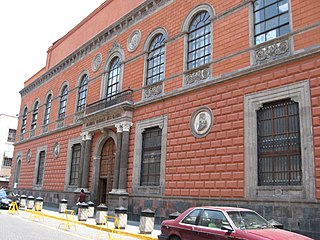 W
WThe Academy of San Carlos is located at 22 Academia Street in just northeast of the main plaza of Mexico City. It was the first major art academy and the first art museum in the Americas. It was founded in 1781 as the School of Engraving and moved to the Academia Street location about 10 years later. It emphasized classical European training until the early 20th century, when it shifted to a more modern perspective. At this time, it also integrated with the National Autonomous University of Mexico, eventually becoming the Faculty of Arts and Design, which is based in Xochimilco. Currently, only graduate courses of the modern school are given in the original academy building.
 W
WFerdinand Freiherr Rosenzweig von Drauwehr was an Austrian military officer and architect.
 W
WThe Mexican Empire was a constitutional monarchy, the first independent government of Mexico and the only former colony of the Spanish Empire to establish a monarchy after independence. It is one of the few modern era, independent monarchies that have existed in the Americas along with the Brazilian Empire and the two Haitian Empires.
 W
WThe First Mexican Republic, known also as the First Federal Republic, was a federated republic, under the Constitution of 1824. It was a nation-state officially designated the United Mexican States. The First Mexican Republic lasted from 1824 to 1835, when conservatives under Antonio López de Santa Anna transformed it into a centralized state, the Centralist Republic of Mexico.
 W
WDon Miguel Gregorio Antonio Francisco Ignacio Hidalgo-Costilla y Gallaga Mandarte Villaseñor, more commonly known as Don Miguel Hidalgo y Costilla or Miguel Hidalgo, was a Spanish Catholic priest, a leader of the Mexican War of Independence, and recognized as the Father of the Nation.
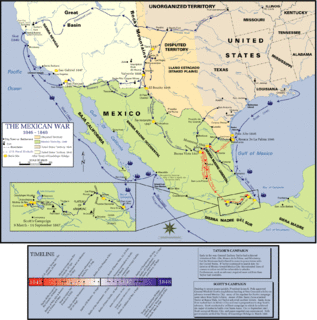 W
WThe Pacific Coast Campaign refers to United States naval operations against targets along Mexico's Pacific Coast during the Mexican–American War. It excludes engagements of the California Campaign in areas of The Californias north of the Baja California Peninsula. The objective of the campaign was to secure the Baja Peninsula of Mexico, and to blockade/capture west-coast ports of Mexico—especially Mazatlan, a major port-of-entry for imported supplies. The resistance of Mexican forces to the north in the Los Angeles area and the lack of ships, soldiers and logistical support prevented an early occupation of the peninsula and the west-coast Mexican seaports. The U.S. Navy attempted blockades of the ports three times before being able to successfully blockade and/or occupy them.
 W
WThe Pastry War, also known as the First French intervention in Mexico or the First Franco-Mexican War (1838–1839), began in November 1838 with the naval blockade of some Mexican ports and the capture of the fortress of San Juan de Ulúa in Veracruz by French forces sent by King Louis-Philippe. It ended several months later in March 1839 with a British-brokered peace. The intervention followed many claims by French nationals of losses due to unrest in Mexico. This incident, the first and lesser of Mexico's two 19th-century wars with France, preceded the French invasion of 1861–67 which supported the short reign of Emperor Maximilian I of Mexico whom the Mexicans executed by firing squad at the end of that later conflict.
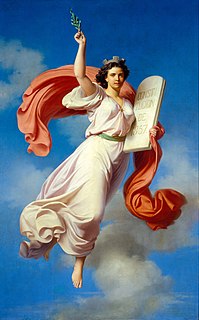 W
WThe Reform laws were a set of anticlerical laws enacted in Mexico between 1855 and 1863, during the governments of Juan Alvarez, Ignacio Comonfort and Benito Juárez that were intended to limit the privileges (fueros) of the Roman Catholic Church and the military. The laws also limited the ability of Catholic Church and indigenous communities from collectively holding land. The liberal government sought the revenues from the disentailment of church property, which could fund the civil war against Mexican conservatives and to broaden the base of property ownership in Mexico and encouraging private enterprise. Several of them were raised to constitutional status by the constituent Congress that drafted the liberal Constitution of 1857. Although the laws had a major impact on the Catholic Church in Mexico, liberal proponents were not opposed to the church as a spiritual institution, but rather sought a secular state and a society not dominated by religion.
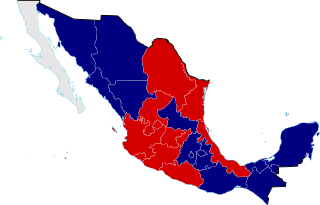 W
WThe War of Reform in Mexico, during the Second Federal Republic of Mexico, was the three-year civil war (1857–1860) between members of the Liberal Party who had taken power in 1855 under the Plan of Ayutla, and members of the Conservative Party resisting the legitimacy of the government and its radical restructuring of Mexican laws, known as La Reforma. The Liberals wanted to eliminate the political, economic, and cultural power of the Catholic church as well as reduce the role of the Mexican Army. Both the Catholic Church and the Army were protected by corporate or institutional privileges (fueros) established in the colonial era. Liberals sought to create a modern nation-state founded on liberal principles. The Conservatives wanted a centralist government, some even a monarchy, with the Church and military keeping their traditional roles and powers, and with landed and merchant elites maintaining their dominance over the majority mixed-race and indigenous populations of Mexico.
 W
WVíctor Rosales;, was a Mexican military officer born in Zacatecas, in the central Viceroyalty of New Spain. Rosales was a field marshal in the Mexican War of Independence.
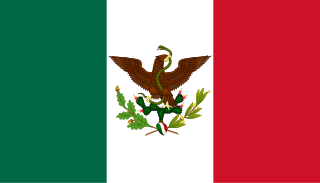 W
WThe Second Federal Republic of Mexico is the name given to the second attempt to achieve a federalist government in Mexico after a period of centralism. Officially called the United Mexican States, a federal republic was established again on August 22, 1846 when interim president José Mariano Salas issued a decree restoring the 1824 constitution. The Second Republic continued to be rocked by the political instability that had characterized Mexico since independence. Mexico's loss in the war with the United States during this time saw half of Mexican territory become part of the United States. Even though Antonio López de Santa Anna played a major role in that loss, he returned to the presidency afterwards, selling further northern territory to the United States. The sale of the Mesilla Valley was for many the final straw, and liberals promulgated of the Plan of Ayutla in 1854, calling for the overthrow of Santa Anna. Santa Anna went into exile and the liberals set about implementing their vision of Mexico.
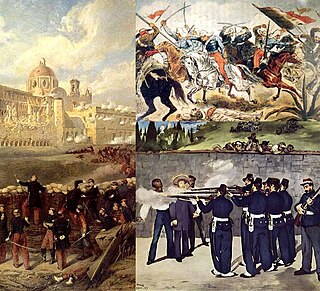 W
WThe Second French Intervention in Mexico, also known as the Second Franco-Mexican War and the Mexican Adventure, was an invasion of Mexico, launched in late 1861, by the Second French Empire (1852–1870). Initially supported by the United Kingdom and Spain, the French intervention in Mexico was a consequence of Mexican President Benito Juárez's imposition of a two-year moratorium of loan-interest payments from July 1861 to French, British, and Spanish creditors. To extend the influence of Imperial France, Napoleon III instigated the intervention in Mexico by claiming that the military adventure was a foreign policy commitment to free trade. The establishment of a European-derived monarchy in Mexico would ensure European access to Mexican resources, particularly French access to Mexican silver. To realize his ambitions without interference from other European nations, Napoleon III of France entered into a coalition with the United Kingdom and Spain.
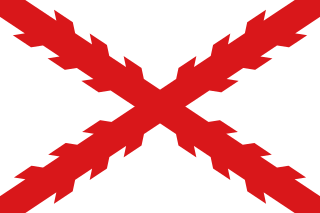 W
WNew Navarre was a province in the Provincias Internas, one of the frontier provinces of the Viceroyalty of New Spain. Brigadier Pedro de Rivera, who visited the northern presidios from 1724 to 1728, suggested to the viceroy Juan de Acuña, Marquis of Casafuerte, the political and administrative reorganization of the northwest provinces. The viceroy supported the idea, and it was approved by Philip V of Spain in 1732, and executed the following year with the appointment of the first governor, Manuel Bernal de Huidobro, at that time mayor of Sinaloa. In the branches of government, finance and war, the governor was directly subject to the viceroy, while the field of justice was under the jurisdiction of the Royal Audience of Guadalajara of the Viceroyalty of New Spain. By 1806, the province was generally recognized as Sonora or Nueva Navarra, with the capital in Arispe, and including the area comprising Sinaloa. After Independence Sonora y Sinaloa became one of the constituent states of the Mexican Republic. The Sonoran Desert ecoregion covers much of the state.
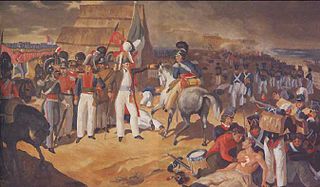 W
WThe Spanish attempts to reconquer Mexico were an effort by the Spanish government to regain possession of its former colony of New Spain, resulting in episodes of war comprised in clashes between the newly born Mexican nation and Spain. The designation mainly covers two periods: the first attempts occurred from 1821 to 1825 and involved the defense of Mexico's territorial waters, while the second period had two stages, including the Mexican expansion plan to take the Spanish-held island of Cuba between 1826 and 1828 and the 1829 expedition of Spanish General Isidro Barradas, which landed on Mexican soil with the object of reconquering Mexican territory. Although the Spanish never regained control of the country, they damaged the fledgling Mexican economy.
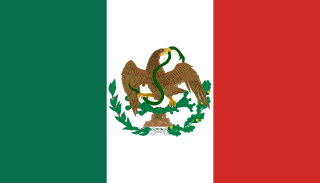 W
WThe Supreme Executive Power was the Provisional Government of Mexico that governed between the fall of the First Mexican Empire in April, 1823 and the election of the first Mexican President, Guadalupe Victoria in October 1824. After Emperor Iturbide abdicated, the sovereignty of the nation passed over to congress which appointed a triumvirate, made up of Guadalupe Victoria, Pedro Celestino Negrete, and Nicolas Bravo, to serve as the executive, while a new constitution was being written.